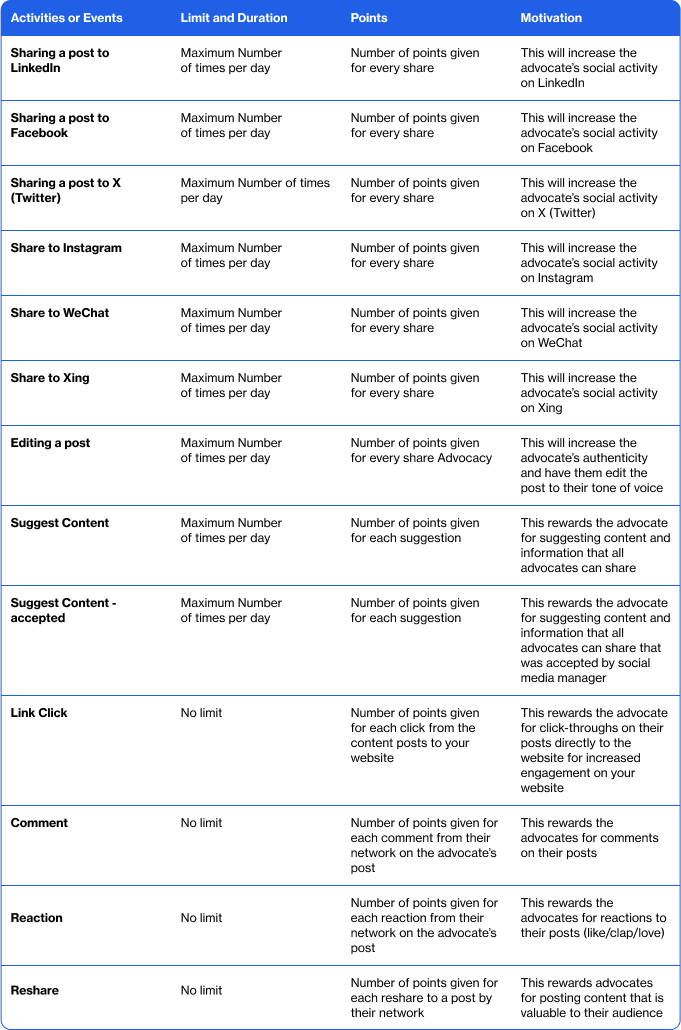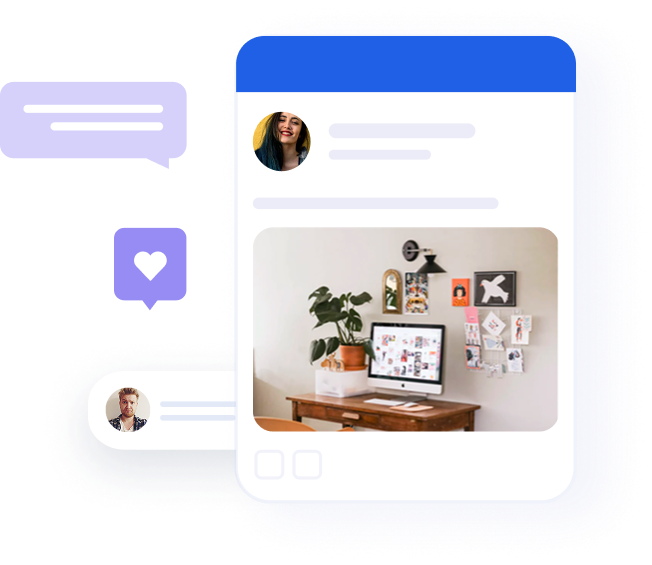
The dos and don’ts of gamifying your employee advocacy program
Table of contents
Why should you gamify your employee advocacy program? Because many people are socially competitive creatures. Whether we beat our personal CrossFit record, score a winning goal, or close the most significant account of the quarter, we need recognition and visibility for our accomplishments. Gamification of activities enables healthy competition between employees and gets everyone motivated to become even more accomplished.
That’s why gamification is a great way to boost participation in your employee advocacy program. We all know employee advocacy adoption is half the battle when running a program. Your teams may lose momentum and it’s up to us, the social media managers, to re-spark their enthusiasm.
Gamification increases enthusiasm by tapping into the psychology of motivation, providing tangible incentives for your team’s advocacy efforts. It involves applying game-like elements—such as points, badges, and leaderboards—to encourage and reward employees for promoting your company’s brand, content, events, and news on social media while turning them into thought leaders at the same time.
Keeping active and posting on social media is a must when you want to develop and maintain your personal branding.
This strategy makes advocacy more engaging, motivating employees to participate by leveraging their natural desires for recognition and achievement. Gamification also significantly boosts employee engagement. A recent survey revealed that 90% of employees feel more motivated at work when their tasks are gamified.
If you’re thinking about gamifying your employee advocacy program, keep reading. We’ll share some common dos and don’ts to consider as you launch your contest.
What needs to be included when gamifying employee advocacy
Do: Put together a well-thought-out training before launch day
Make the rules of the game clear from the get-go. Your training should include why you’re launching advocacy, what’s in it for your employees, and explain the rules of the game. Walk through with your advocates the goals of the contest, how to win, which actions are rewarded, and various prizes your advocates can take home. Think about ways to make your training program exciting and fun to start your competition on the right foot–with your employees ready to win!
Don’t: Start gamifying without instructions
Before launching your contest, your employees need to know how they can be successful. Failure to communicate the game plan will confuse and reduce enthusiasm for your competition.
Do: Base your rewards on the specific goals of your advocacy program
Your contest should reward actions that will help you advance your organization’s marketing goals.

It’s best to use a point system so you can put more emphasis on the specific actions that are most important to your program.
For example, you can reward 20 points each time someone puts advocacy content into their own voice to encourage authenticity, 10 points for every like, and 15 points for every comment they generate. Don’t complicate the math, just use the scoring to help create the engagement you need.
Don’t: Reward the number of shares without considering best practices
The last thing you want your advocates to do is to spam your followers. While networks like X are conducive to multiple posts per day, it is not recommended to post more than once per day on LinkedIn. Make sure your program takes this into account by capping the number of shares based on best practices to help position your advocates as meaningful thought leaders.
Do: Segment your advocates into groups
There are many ways you can segment your advocates to level the playing field. You can do it by team, by location, or even based on their proficiency with advocacy. Here’s one way we suggest classifying advocates based on their level of expertise as an advocate:

By dividing the competition into several groups, you increase everyone’s chance to shine! This will help keep motivation strong and enable you to cater training to diverse talents or teams. You can also have different reward categories for various accomplishments.
For example, if an employee never participated in advocacy before and you saw a sudden uptick in their efforts, they could be your ‘rising star’ whereas an advocate that generated the most engagement can win the ‘most engaging content award’.
Don’t: Make your contest too big
Competition is only fun if you feel you have a chance to win. Especially if you work for a large organization, it’s easy for your advocates to feel lost on your leaderboard, trying to rise to the top of a list of thousands of employees. This can also happen if you have specific employees such as executives who have large networks with an extremely engaged audience. In order for gamification to be successful, each of your advocates needs to feel empowered to win. They shouldn’t need to have the best connections in the industry or 20 years of experience in the field. It’s important to level the playing field so each employee feels motivated to participate. You can separate your people into groups that are similar and that have a fair chance to win
Do: Find ways to keep your advocates engaged throughout the competition
A bit of motivation goes a long way in maintaining the enthusiasm of your advocates. This can be achieved in several ways: by using a leaderboard to display their ranking in relation to their peers, making announcements to highlight the narrow point gaps between team members and spur them on to earn more, giving weekly shoutouts to the top three participants, or offering small rewards periodically. These strategies are key to keeping your advocates engaged and motivated.
Don’t: Forget to continuously motivate your advocates
Your involvement in your company’s competition doesn’t pause training and pick back up once the contest is over. You need to be your advocates’ biggest cheerleader, motivating them to keep going and take their efforts to the next level.
Do: Keep it fun, exciting, and engaging throughout
Enthusiasm is contagious, starting from you and trickling down. For gamification to succeed, the competition must be enjoyable. Your own excitement is essential to ignite others’ enthusiasm, and your communication about the contest should amplify this excitement. Keep your messaging upbeat, supportive, and enjoyable, creating an atmosphere that makes everyone eager to join the fun.
Don’t: Make your contest all work, no play
The last thing you want is for the contest to feel forced and for your advocates to feel pressured to participate. Instead of making the contest about the organization, make it about the advocate and what they’ll gain.
Help your employees build their professional social profiles and turn them into champions
By designing your advocacy program with gamification at its core, you’re not just encouraging your employees to promote your brand; you’re creating an engaging competition where they can celebrate their personal triumphs as well as the collective success of their teams.
Keep your contest engaging and enjoyable, and watch as your team’s enthusiasm transforms your brand’s presence on social media and beyond. Start with clear, fun training; reward meaningful contributions over mere activity; maintain momentum with continuous encouragement; and above all, ensure the game is worth playing for everyone.
Here’s to turning your employee advocacy program into a fun contest, bolstering your brand’s story with every share, like, and comment.
Ready to start building an engaging employee advocacy platform for your employees? Check out Oktopost’s employee advocacy platform.
Extra Tip
When planning your scoring process for gamification make sure you are well-versed in each metric that can be scored
Here is a short table with a quick explanation:





